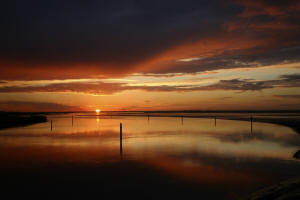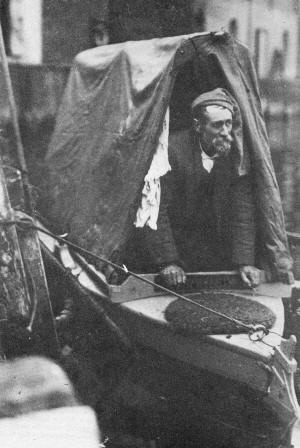| Breydon Water is a large estuary lying just to
the east of Great Yarmouth.
The Rivers Waveney and
Yare enter Breydon before
discharging into the North Sea.

Breydon Water Sunset ©
Phil Carpenter
Breydon is approximately four miles long and one mile wide
and its water is brackish in character. At low tide,
acres of mud-flats are exposed which provide the perfect
environment for wading birds and other wildfowl.

Arthur Patterson in his
house-boat
Arthur Patterson (1857-1935) is probably the writer
most closely associated with Breydon Water. He was the
youngest of nine children and was born in the
Yarmouth Rows - the son of a shoemaker. From an early age he was passionate
about wildlife and spent most of his spare time teaching
himself about the plants
and animals of Breydon. He worked as a pedlar, a
salesman, warehouseman and zookeeper before landing a
permanent job as a truant officer.
At the age of 71 he wrote Wild Fowlers and
Poachers (1929) - a delightful memoir of his life
time on Breydon - celebrating the punt-gunners, fishermen,
wild-fowlers, eelers, smelters and poachers that he had
known. Many of these men frequented the (now demolished) Bowling Green
public house on North Quay.
Rather bizarrely, Wild Fowlers and Poachers was typed by one of
Patterson's disciples - a certain Edward Augustine Ellis who was,
himself, destined to play a huge part in the
conservation of Norfolk's
wildlife - namely at Wheatfen Broad near Surlingham.
In total, Patterson wrote 26 books and hundreds of
articles, leaflets and periodicals. For many years he
contributed nature articles to the Eastern Daily Press in
Norwich - publishing under the modest pseudonym of John Knowlittle. In the last year of his
life he was honoured
by being elected as an Associate Member of the Linnean
Society in London.
Eric Fowler (alias Jonathan Mardle) who met Patterson
once described
him as: '...a little, wiry, bearded man, wrinkled and
weather-beaten, but very active and bright-eyed, like
one of the dunlin he loved to watch on Breydon
mud-flats.'
Breydon Water also provides the setting for the
exciting denouement of Arthur Ransome's children's story
Coot Club (1934). Mrs Barrable
and the children, in the Teasel
and the Titmouse, run aground in the fog and the
Margoletta and her crew of Hullabaloos, who they
have been avoiding since leaving
Horning, close in
on them. Fortunately, though, the Hullabaloos hit a post
and the Margoletta is wrecked. Here is Ransome's
ominous description of the arrival of the Margoletta:
|

